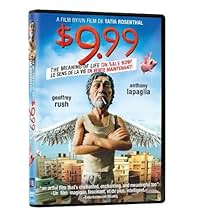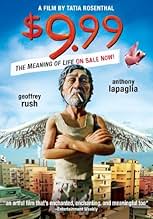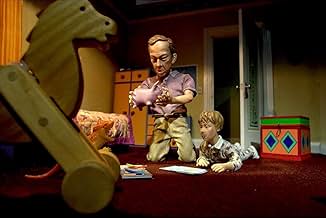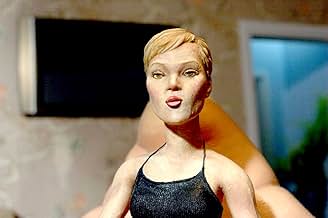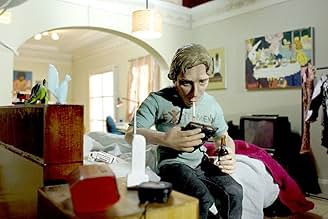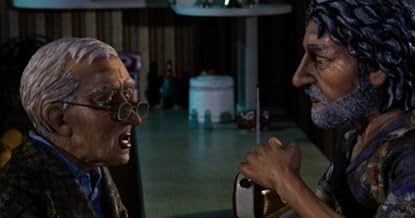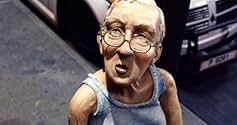AVALIAÇÃO DA IMDb
6,7/10
3,6 mil
SUA AVALIAÇÃO
Adicionar um enredo no seu idiomaFollows people living in a Sydney apartment complex looking for meaning in their lives.Follows people living in a Sydney apartment complex looking for meaning in their lives.Follows people living in a Sydney apartment complex looking for meaning in their lives.
- Direção
- Roteiristas
- Artistas
- Prêmios
- 3 vitórias e 4 indicações no total
Geoffrey Rush
- Angel
- (narração)
Anthony LaPaglia
- Jim Peck
- (narração)
Samuel Johnson
- Dave Peck
- (narração)
Barry Otto
- Albert
- (narração)
Joel Edgerton
- Ron
- (narração)
Claudia Karvan
- Michelle
- (narração)
Ben Mendelsohn
- Lenny Peck
- (narração)
Leeanna Walsman
- Tanita
- (narração)
Jamie Katsamatsas
- Zack
- (narração)
Brian Meegan
- Clement
- (narração)
Roy Billing
- Marcus Portman
- (narração)
- …
David Field
- Sammy
- (narração)
Henry Nixon
- Drazen
- (narração)
- …
Richard Clendinnen
- Policeman #2
- (narração)
Emile Sherman
- The Messenger
- (narração)
Ursula Yovich
- Camille
- (narração)
Avaliações em destaque
I was so surprised to see so many negative reviews for this movie because I thought it was absolutely brilliant!
Some people found the animation ugly whereas the movement seemed very smooth to me and the realistic expression and emotion they were able to portray with clay faces astounded me! The claymation style was too realistic for me at first, not cartoon-y enough, which gave the movie a very creepy disturbing feel. There are a lot of reds and purples used in the faces that can make the characters seem sickly, but you come to realise that this is a stylistic choice that makes the faces more varied and more like pieces of art than just moving toys. Art is supposed to disturb the comfortable anyhow and this movie does it very well.
I have also heard the movie be critiqued for its jumpy, disconnected plot (it is based on a collection of short stories) whereas I felt that the thematic connections were strong enough that this movie very much felt like a unified whole. The characters are connected by the apartment complex they share and by the kinds of lives they lead and the kinds of problems they face in the plot.
I loved the dialogue in this movie, one of those great works where subtle, very real moments and shifts in relationships are defined by the idiosyncratic way a line is worded in a conversation between characters. I was wrapped entirely in every conversation and each line seemed to carry so much meaning (in a light-hearted kind of way).
The stores range from touching, sweet and hopeful to disturbing and depressing send-ups of life in a post-modern age. You really can take from this what you want- but not because the filmmakers have made ideas vague and unfleshed, but because they have taken so many ideas and fleshed them out in so many different and unexpected ways that you have a whole smorgasboard of meaning to pick, choose, riff on, dissect, abstract and so on.
I don't want to hype it too much because I think part of my love for this movie was due to similarities I have with some characters and how connected this made me feel but please don't dismiss this movie, because it is definitely something very special!
Some people found the animation ugly whereas the movement seemed very smooth to me and the realistic expression and emotion they were able to portray with clay faces astounded me! The claymation style was too realistic for me at first, not cartoon-y enough, which gave the movie a very creepy disturbing feel. There are a lot of reds and purples used in the faces that can make the characters seem sickly, but you come to realise that this is a stylistic choice that makes the faces more varied and more like pieces of art than just moving toys. Art is supposed to disturb the comfortable anyhow and this movie does it very well.
I have also heard the movie be critiqued for its jumpy, disconnected plot (it is based on a collection of short stories) whereas I felt that the thematic connections were strong enough that this movie very much felt like a unified whole. The characters are connected by the apartment complex they share and by the kinds of lives they lead and the kinds of problems they face in the plot.
I loved the dialogue in this movie, one of those great works where subtle, very real moments and shifts in relationships are defined by the idiosyncratic way a line is worded in a conversation between characters. I was wrapped entirely in every conversation and each line seemed to carry so much meaning (in a light-hearted kind of way).
The stores range from touching, sweet and hopeful to disturbing and depressing send-ups of life in a post-modern age. You really can take from this what you want- but not because the filmmakers have made ideas vague and unfleshed, but because they have taken so many ideas and fleshed them out in so many different and unexpected ways that you have a whole smorgasboard of meaning to pick, choose, riff on, dissect, abstract and so on.
I don't want to hype it too much because I think part of my love for this movie was due to similarities I have with some characters and how connected this made me feel but please don't dismiss this movie, because it is definitely something very special!
Would you still appreciate the miracle of being alive, after seeing $9.99 ? Personally, I would not.
Made up of Israeli writer Etgar Keret's several short stories, $9.99 is a black comedy satirizing social manners and discontents of today's urban nation. Within a high density of morbid humour, the purpose of black comedy is somewhat achieved. Israeli animation director Tatia Rosenthal is trying to provoke discomfort and serious thought about the social matters that makes life unbearable, in the audience. From couple years earlier another animation of her "A Buck's Worth" seems to be the nucleus of $9.99.
Besides the production values, technical values are at a very low-level. Of course, it's not fair to expect a flawless claymation like they do in Hollywood, but still the characters look and move very distractive. Audio mix is not satisfying either. Plus it's very silent and the music is very boring, while the social lampoon is in charge of the mood. Alongside with the unpleasant characters, these are the main reasons why a lot of people hated this film.
4 households of one apartment block form the main characters and the plot. The first one is a broken family, a father and his two adult sons leaving apart from the mother of their home. Dave, the youngest kid is the leading character in the story. He is a very likable kid; honest but dupe, helpful and skillful but unemployed. His brother works as a bailiff; smart, self-confident, happy-go-lucky. The father of the family is self-disciplined, strict, introverted, snooty; throughout the story Dave's father always ignores his son and always extremely ironic incidents happen to him, thus he becomes depressed and turns out to be pessimistic. While the story comes to a resolution, he no longer has any eagerness to do a thing; he loses his aim of life. That's when Dave comes to his rescue, offering him fresh ideas of finding the hidden meaning of life.
Opening with a dark view of life, that view becomes brighter and softer even though the story develops with sad and ironic incidents happening to regular people. Rather than some intelligent black humour, there's nothing interesting or to be of liking. I watched this film with my friends and their friends altogether on a boring Saturday afternoon, and everyone hated it, so we turned it off in the middle; since no one really cared whatever is going to happen to those unpleasant and uninteresting people. Then after a while, I watched it on my own forcing myself to see how the conclusion is going to be. I've seen much more awful animations. This was somewhat tolerable.
Besides the production values, technical values are at a very low-level. Of course, it's not fair to expect a flawless claymation like they do in Hollywood, but still the characters look and move very distractive. Audio mix is not satisfying either. Plus it's very silent and the music is very boring, while the social lampoon is in charge of the mood. Alongside with the unpleasant characters, these are the main reasons why a lot of people hated this film.
4 households of one apartment block form the main characters and the plot. The first one is a broken family, a father and his two adult sons leaving apart from the mother of their home. Dave, the youngest kid is the leading character in the story. He is a very likable kid; honest but dupe, helpful and skillful but unemployed. His brother works as a bailiff; smart, self-confident, happy-go-lucky. The father of the family is self-disciplined, strict, introverted, snooty; throughout the story Dave's father always ignores his son and always extremely ironic incidents happen to him, thus he becomes depressed and turns out to be pessimistic. While the story comes to a resolution, he no longer has any eagerness to do a thing; he loses his aim of life. That's when Dave comes to his rescue, offering him fresh ideas of finding the hidden meaning of life.
Opening with a dark view of life, that view becomes brighter and softer even though the story develops with sad and ironic incidents happening to regular people. Rather than some intelligent black humour, there's nothing interesting or to be of liking. I watched this film with my friends and their friends altogether on a boring Saturday afternoon, and everyone hated it, so we turned it off in the middle; since no one really cared whatever is going to happen to those unpleasant and uninteresting people. Then after a while, I watched it on my own forcing myself to see how the conclusion is going to be. I've seen much more awful animations. This was somewhat tolerable.
$9.99 is a series of unique short stories. However the tales are a bit uneven and get a little artsy at the end leaving you a bit confused.
$9.99 is a stop motion claymation film that centers around an apartment complex in Australia and follows the tale of about eight or so of its inhabitants. To give you a sample: there is a boy who loves soccer and is saving up for a soccer toy. There is a father who witnesses two deaths right before his eyes and has two son's who aren't exactly successful. There is an old man who everyone ignores because he yammers constantly about his dead wife. And there is a stoner/alcoholic who gets faded and hallucinates about three miniature druggie friends.
I have to say... the intro to this film is really enthralling. I won't give it away but it definitely grabbed my attention. It's quirky, sad and violent which definitely covers the multiple tones of this film.
The characters and stories are sporadically interspersed and no one story gets priority over another. And I think because of that indecision it sort of holds the movie back. Some of the stories aren't that interesting in the beginning but about 20 minutes into the film one of the characters turns out to be a living Angel, with wings! Now the Angel of course is the most intriguing of the stories, which is why he is on the cover of the movie poster and also probably why an Israeli funded commission helped fund this film. Now I think if the film didn't have the angel $9.99 wouldn't have kept my attention the way it did. I stayed attentive because I wanted to know the significance of the angel. However the Angel story doesn't come to a conclusion like some of the others which drove me crazy! All the other stories had a solid but not always satisfying ending. However the angel story just sort of "dropped off" (inside joke). I understand the angel changed these characters lives in some way and manner but why did he change their lives and why not all in the same manner either positive or negative?
Perhaps there is some biblical homage that I don't understand because I'm not that well read in religious texts but I find this to be the biggest detraction from the film. Also I don't mind the surreal hallucinations by the druggie but the story about the man who shaves himself to satisfy his lover - WTF happened at the end!? Is that real or not real? I can't tell you what happens because it ruins the surprise but lets just say some world mechanics were definitely broken.
All in all the film is quite idiosyncratic and moves at a very odd pace. I think if I were stoned this movie might have been too much to handle, but definitely check it out if you have an open mind and like seeing weird things.
$9.99 is a stop motion claymation film that centers around an apartment complex in Australia and follows the tale of about eight or so of its inhabitants. To give you a sample: there is a boy who loves soccer and is saving up for a soccer toy. There is a father who witnesses two deaths right before his eyes and has two son's who aren't exactly successful. There is an old man who everyone ignores because he yammers constantly about his dead wife. And there is a stoner/alcoholic who gets faded and hallucinates about three miniature druggie friends.
I have to say... the intro to this film is really enthralling. I won't give it away but it definitely grabbed my attention. It's quirky, sad and violent which definitely covers the multiple tones of this film.
The characters and stories are sporadically interspersed and no one story gets priority over another. And I think because of that indecision it sort of holds the movie back. Some of the stories aren't that interesting in the beginning but about 20 minutes into the film one of the characters turns out to be a living Angel, with wings! Now the Angel of course is the most intriguing of the stories, which is why he is on the cover of the movie poster and also probably why an Israeli funded commission helped fund this film. Now I think if the film didn't have the angel $9.99 wouldn't have kept my attention the way it did. I stayed attentive because I wanted to know the significance of the angel. However the Angel story doesn't come to a conclusion like some of the others which drove me crazy! All the other stories had a solid but not always satisfying ending. However the angel story just sort of "dropped off" (inside joke). I understand the angel changed these characters lives in some way and manner but why did he change their lives and why not all in the same manner either positive or negative?
Perhaps there is some biblical homage that I don't understand because I'm not that well read in religious texts but I find this to be the biggest detraction from the film. Also I don't mind the surreal hallucinations by the druggie but the story about the man who shaves himself to satisfy his lover - WTF happened at the end!? Is that real or not real? I can't tell you what happens because it ruins the surprise but lets just say some world mechanics were definitely broken.
All in all the film is quite idiosyncratic and moves at a very odd pace. I think if I were stoned this movie might have been too much to handle, but definitely check it out if you have an open mind and like seeing weird things.
An Australian-Israel independent animation clay movie that tells the story of a group of lonely people living in the same block of apartments. The story is told, mainly through 28y.o. unemployed Dave Peck, who buys books by post for only $9.99, one of them about the meaning of life. But we also see his depressive father, his disconnected brother, a commercial sexy model, an elderly widower, a father living with his only child, a young couple in crisis, an "angel", and a former magician.
This is a film for adults that examines adult themes (loneliness, immaturity, lack of love and purpose in life, lack of communication in society), with drug use, nudity and explicit sex scenes included. It also has some surrealist touches in between, that I found delightful.
The clay animation is very cartoonish in a way, odd-looking at first, but very original, with great movement and good facial expressions, realistic clothing and body language. I loved all the decoration of the flats, all the little details inside them, which help to draw visually the character of the people living in them. The city landscapes and city spots are also lovely. The colours and mood of the movie are excellent, and also the music.
The individual stories are great - fresh, believable, and poignant. They depict well the sins and deficiencies of modern society, and the social distress in which many people live. They also show real Australian characters and attitudes, those that you'd find in real world, in your own block of apartments. Raw Australia without sweetener.
The main problem of the movie is the lack of a real plot. In most cases we are just witnesses of the lives of those people, but we do not understand why are in a certain state or why they act in a certain way, what troubles them inside and moves them to act in a certain way - Lack of depth. Only after watching the movie, I learnt that the story is based in different short stories by Etgar Keret, which explains in part the lack of harmony of the film, and the disconnection of some of the individual stories. The scriptwriter is to blame for not finding an element that gives consistency to the whole film and not blending well the individual stories.
In fact, the aim of the movie might not be clear to the viewer. All the part about the purchase of books is unnecessary. Many people will think that the meaning of life is what the movie is all about, when in fact the movie shows that life does not have any meaning, at least for the characters of the story, and that life is what it is. So, why confusing the viewer with elements that don't add anything to the characters or the story line? I think it is a very interesting and original film with great characters that deserves to be watched despite its flaws.
This is a film for adults that examines adult themes (loneliness, immaturity, lack of love and purpose in life, lack of communication in society), with drug use, nudity and explicit sex scenes included. It also has some surrealist touches in between, that I found delightful.
The clay animation is very cartoonish in a way, odd-looking at first, but very original, with great movement and good facial expressions, realistic clothing and body language. I loved all the decoration of the flats, all the little details inside them, which help to draw visually the character of the people living in them. The city landscapes and city spots are also lovely. The colours and mood of the movie are excellent, and also the music.
The individual stories are great - fresh, believable, and poignant. They depict well the sins and deficiencies of modern society, and the social distress in which many people live. They also show real Australian characters and attitudes, those that you'd find in real world, in your own block of apartments. Raw Australia without sweetener.
The main problem of the movie is the lack of a real plot. In most cases we are just witnesses of the lives of those people, but we do not understand why are in a certain state or why they act in a certain way, what troubles them inside and moves them to act in a certain way - Lack of depth. Only after watching the movie, I learnt that the story is based in different short stories by Etgar Keret, which explains in part the lack of harmony of the film, and the disconnection of some of the individual stories. The scriptwriter is to blame for not finding an element that gives consistency to the whole film and not blending well the individual stories.
In fact, the aim of the movie might not be clear to the viewer. All the part about the purchase of books is unnecessary. Many people will think that the meaning of life is what the movie is all about, when in fact the movie shows that life does not have any meaning, at least for the characters of the story, and that life is what it is. So, why confusing the viewer with elements that don't add anything to the characters or the story line? I think it is a very interesting and original film with great characters that deserves to be watched despite its flaws.
$9.99 came and went from theaters, but it sticks out very nicely on On Demand, which is where I ultimately saw the little 70-minute claymation movie (I could say stop-motion animated, which it is, but it is very much in the clay tradition of practically being able to see the fingerprints on the characters' bodies and faces). It's about... I suppose how to live a life, I suppose, and that's emphasized by the book that keeps popping up periodically in the film- which you can buy for $9.99 (in the movie, not in real life, I think anyway)- that tells what the Meaning of Life is... that is, it gives a lot of other offers for books on how to deal with this or that in life. It almost looks like a coupon book, which is a shame since the character who is most in love with it, a nice kid, seems very much engrossed by it.
But the title of Tatia Rosenthal's film is more like rounding off reality, perhaps. It's not a full $10, but the characters do try to make that price in their lives. To put it another way, no one character in this film is quite happy, but they keep trying, and maybe life will have some meaning when they can attain some happiness - or not, as case might be. Rosenthal's film, based on short stories Etgar Keret, focus on a group of people who have some, um, quirks to them, or are just painfully normal. The film begins with a middle-aged businessman turning down a homeless man a dollar for a coffee, and the homeless guy pulls out a gun and shoots himself. He later returns as an Angel and hangs out with an old guy on his porch, smoking cigarettes and wondering what Heaven is like. The businessman's sons: one is the Meaning of Life book-reader, and the other is a repo man who falls hard for a sexy (as sexy as claymation can be) model, and proceeds to shave his whole body with hair - and then takes a cue from the organ-less men who removed their body parts until they were heads and blobs. All for love, I guess.
Other stories are a little more ordinary, more or less. More: a little boy is told by his father to put away fifty cents in his piggy bank so he can save up to buy a toy, but he finds that he grows attached to the piggy bank, who he names, and finds the piggy's smile very comforting ("I put money in, he smiles, I don't put money in... he smiles!"). Less: a guy whose girl really wants to settle down and marry and have kids and all of that, but finds that he would rather spend time in his room, listening to records with his three little "friends", little men ala Gulliver's Travels, and getting wasted on beer and pot. So the stories are mostly by themselves, but intertwine by certain events (such as the Angel doing a test "fly" off of the patio and with everyone else looking out the window), or by thematic context.
The stories have a lot of humor to them, with one-liners that zing ("I found that there's not one meaning to life, there's six!"), and the look of the film feels similar but is original in its own right of character design and approach (and, for once, we get a rated-R claymation movie, including full frontal nudity!), but it also goes for deep moments and resonance, and Rosenthal strikes some good ground here. She doesn't try and over-do the messages, but lets them speak for themselves through the stories. It's genuinely odd, but it also gives heart-felt scenes and passages, such as the little boy with the piggy bank (the end of his story with the bank is quite touching), and it values the power of human responsibility with fantasy in equal measure. If it were a little longer it might really be something great, but as it stands it's a curious little find.
But the title of Tatia Rosenthal's film is more like rounding off reality, perhaps. It's not a full $10, but the characters do try to make that price in their lives. To put it another way, no one character in this film is quite happy, but they keep trying, and maybe life will have some meaning when they can attain some happiness - or not, as case might be. Rosenthal's film, based on short stories Etgar Keret, focus on a group of people who have some, um, quirks to them, or are just painfully normal. The film begins with a middle-aged businessman turning down a homeless man a dollar for a coffee, and the homeless guy pulls out a gun and shoots himself. He later returns as an Angel and hangs out with an old guy on his porch, smoking cigarettes and wondering what Heaven is like. The businessman's sons: one is the Meaning of Life book-reader, and the other is a repo man who falls hard for a sexy (as sexy as claymation can be) model, and proceeds to shave his whole body with hair - and then takes a cue from the organ-less men who removed their body parts until they were heads and blobs. All for love, I guess.
Other stories are a little more ordinary, more or less. More: a little boy is told by his father to put away fifty cents in his piggy bank so he can save up to buy a toy, but he finds that he grows attached to the piggy bank, who he names, and finds the piggy's smile very comforting ("I put money in, he smiles, I don't put money in... he smiles!"). Less: a guy whose girl really wants to settle down and marry and have kids and all of that, but finds that he would rather spend time in his room, listening to records with his three little "friends", little men ala Gulliver's Travels, and getting wasted on beer and pot. So the stories are mostly by themselves, but intertwine by certain events (such as the Angel doing a test "fly" off of the patio and with everyone else looking out the window), or by thematic context.
The stories have a lot of humor to them, with one-liners that zing ("I found that there's not one meaning to life, there's six!"), and the look of the film feels similar but is original in its own right of character design and approach (and, for once, we get a rated-R claymation movie, including full frontal nudity!), but it also goes for deep moments and resonance, and Rosenthal strikes some good ground here. She doesn't try and over-do the messages, but lets them speak for themselves through the stories. It's genuinely odd, but it also gives heart-felt scenes and passages, such as the little boy with the piggy bank (the end of his story with the bank is quite touching), and it values the power of human responsibility with fantasy in equal measure. If it were a little longer it might really be something great, but as it stands it's a curious little find.
Você sabia?
- CuriosidadesYou can see a record in this film called "The Dark Side of the Room" by the band Pink Wall. This is a play on words of Pink Floyd, The Wall and The Dark Side of the Moon
- ConexõesFeatured in The Rotten Tomatoes Show: Star Trek/Rudo y Cursi/Next Day Air (2009)
Principais escolhas
Faça login para avaliar e ver a lista de recomendações personalizadas
- How long is $9.99?Fornecido pela Alexa
Detalhes
- Data de lançamento
- Países de origem
- Centrais de atendimento oficiais
- Idioma
- Também conhecido como
- 9,99 долларов
- Locações de filme
- Empresas de produção
- Consulte mais créditos da empresa na IMDbPro
Bilheteria
- Faturamento bruto nos EUA e Canadá
- US$ 52.384
- Fim de semana de estreia nos EUA e Canadá
- US$ 478
- 14 de dez. de 2008
- Faturamento bruto mundial
- US$ 708.354
- Tempo de duração1 hora 18 minutos
- Cor
- Mixagem de som
- Proporção
- 1.85 : 1
Contribua para esta página
Sugerir uma alteração ou adicionar conteúdo ausente



